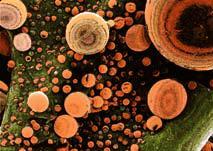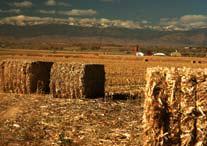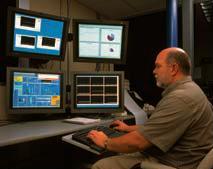Producing Fuels from Plants
The U.S. Department of Energy's Bioenergy Research Center does everything from chemical and biochemical analyses to bioengineering to process scale-up to microbial strain development.
Powering businesses, homes and cars with fossil energy—such as coal, oil and natural gas—has been a source of increasing concern for years, mainly because of the consequences of humanproduced climate change and global warming from greenhouse gases, primarily carbon dioxide.
The U.S. Department of Energy’s Bioenergy Research Center at the National Renewable Energy Laboratory (NREL), in Golden, Colorado, has zeroed in on the goal of producing liquid transportation fuels that are derived from renewable resources such as plant biomass and algae to alleviate and ultimately eliminate the addition of more carbon dioxide to the earth’s atmosphere.
“In the short term we’re focused on producing ethanol from lignocellulosic biomass, the parts of the plants that are used to provide their structure,” says Mike Cleary, National Bioenergy Center director.
“This is unlike the way we produce ethanol today, which is either from the starches that are found in corn or the sugars in sugar cane,” he adds. “So, our goal is to work on technologies that allow us to break down all the plant’s matter rather than just the starchy parts of the plant.”
The process
Mother Nature produces a complex multilaminated material to make plants stand up straight. The main component of this material is cellulose, the most abundant of all naturally occurring organic compounds. Cellulose is built of the same sugars that go into starches, but with a single change in the chemical bond—from an alpha to a beta in a 1, 4 linkage—it becomes a material that is much more difficult to break down by most living organisms.
Inside the human mouth, for example, there is an abundance of enzymes that can break down starches, but there are only a few organisms in the world—fungi, termites and microorganisms in a cow’s stomach— that can break down cellulose. The break-down product from both of these processes is the same as from starch: glucose, a simple sugar.
“Our goal is to break down lignocellulose and turn it into sugars so that we can ferment those sugars, back into alcohols the same way you would with starch or malted barley in a brewery to make beer, or grape sugar to make wine,” Cleary explains.
But this process is complicated by the fact that the cellulose is wrapped with a lot of other non-readily digestible materials, mainly hemicelluloses and lignin. Lignin is a complex phenolic material that acts as a glue to hold the strands or fibers of cellulose together to give rigidity to the plant material.

The thermal pretreatment of lignocellulosic biomass disperses the glue-like lignin into droplets of varying sizes. In this falsecolor image from NREL’s Biomass Surface Characterization Laboratory, the lignin droplets, shown in orange, range from 50 to 10,000 nm in diameter.
Cleary and his team have the task of figuring out how to open up this structure so that enzymes can be added to break it down into sugars that can be fermented into ethanol and other biofuels using an economically viable process.
Two routes
There are actually two ways to break down lignocellulose: biochemical conversion and thermochemical conversion.
With biochemical conversion, scientists take biomass, for example agricultural waste such as corn stover— leaves and stalks—and chemically treat it to open up the structure before enzymes do their job and break it down into sugars.
“Once you’ve achieved the ability to make sugars cheaply, there are lots of organisms [and] lots of companies working on making fuels from them,” Cleary says.
By contrast, the thermochemical route involves taking the plant biomass and cooking it in the absence of oxygen, which, instead of burning it, breaks it down partially to a liquid or completely into a gaseous state—a product known as synthesis gas.

Currently, ethanol is primarily produced from the starch in kernels of field corn. NREL researchers in the DOE Biofuels Program are developing technology to also produce ethanol from the fibrous material (cellulose and hemicellulose) in corn stalks and husks or other agricultural or forestry residues.
“The focus is on producing gas that is heavily concentrated in carbon monoxide and hydrogen,” Cleary explains. “Those are really the ultimate gas break-down products that you’re looking for from biomass.
“This synthesis gas can then be used as the starting point to synthesize hydrocarbon biofuels using technologies that were developed as far back as World War II, when Germany was producing synthesis gas from coal to make diesel.”
Germany was not a gasoline producer during World War II; therefore, its entire army was dependent on diesel. The country generated thousands of barrels of diesel a day from coal. But Cleary’s center is focused on using plant biomass, not coal or natural gas, as the starting material.
Another method of producing fuel using the thermochemical route is to cook down the biomass and stop when it turns liquid, before it becomes a gas. The oil-like compound, called pyrolysis oil, has the potential of being purified into something known as a biocrude, a crude oil substitute that can then be processed into transportation fuel using existing oil-refining technologies.
“It’s not anything like crude oil, because it has a lot of different chemical properties, including more oxygen and other ‘contaminants’ not found in crude oil. So it needs to be upgraded to eliminate them. But if that is accomplished, it’s much more energy dense and then can be used just like crude oil as an intermediate for the production of fuels,” explains Cleary.
Range of disciplines
In order to accomplish the goals of the center, Cleary looks for a very broad range of scientific disciplines, including biochemistry, enzymology, microbiology, molecular biology, chemical catalysis and bioengineering, for his workforce.
For research and development involving the biochemical and thermochemical routes for developing biofuels, he looks for researchers with strong analytical capabilities and a good understanding of the compositional analyses of biomass.
“One of the things we need to do is to characterize this material,” he says. “It’s a complex, heterogeneous material, so we do a lot of wet chemical analysis to determine the composition in terms of how much is cellulose, how much is hemicellulose and how much is lignin.
“We then employ more efficient spectrometric methods, such as nearinfrared [NIR] spectroscopy to rapidly produce analyses of thousands of samples.”
The center also looks for specialized chemical engineering personnel who can identify the kinds of equipment required to break this material down or pretreat it under specific temperature, pressure and pH conditions.
Researchers are also needed to study those specific enzymes most useful for breaking down the biomass and to identify and genetically manipulate the microorganisms that convert the sugars into ethanol in order to improve their conversion efficiency.
“We work with bacteria and yeast that have been genetically engineered to not just metabolize glucose from the cellulose into ethanol but can also take pentoses such as xylose and arabinose from the hemicelluloses and convert them to ethanol as well,” Cleary explains
The center does everything from chemical and biochemical analyses to bioengineering to process scale-up to microbial strain development.

The Thermochemical Users Facility (TCUF) is equipped with sophisticated data monitoring and operation control systems. This control room monitors all key operating parameters simultaneously.
“We have everything from molecular biologists and microbiologists to biochemical engineers, chemical engineers, analytical chemists and NMR spectroscopers,” Cleary explains. “If you pick a discipline in one of those areas, we have at least one or two Ph.D.s working in that area.”
Approximately 40 employees of the 120 who make up the Biomass Research Center are Ph.D. researchers. After the Photovoltaic Research Center, the Biomass Research Center is the second largest within NREL.

Biochemical Processing Pilot Development Unit
Clientele
Approximately 80 percent of the Biomass Research Center’s funding comes from the Department of Energy (DOE). Additionally, the center relies on grants from other government agencies as well as cooperative research and development agreements (CRADAs) with industrial companies.
“So we have various sources of funding that drive our R&D laboratory, but the primary one is the Department of Energy’s Biomass program,” Cleary says.
“The only small jobs that we take are associated with compositional analysis of different kinds of biomass, whether it is agricultural wastes— primarily corn stover—bagasse, which is the residue from sugar cane, and wheat straw or other herbaceous or woody biomass feedstocks, such as switchgrass and poplar.”
Switchgrass and poplar are not yet produced in commercial amounts, but are expected to be among the dedicated bioenergy crops of the future.
Unique challenges of an alternative energy lab
When it comes to the science disciplines that are required to run a lab such as the Biomass Research Center, a main ingredient is diversity.
“We need people who are algal microbiologists,” Cleary explains. “We need process engineers who understand the scale-up of getting from the shake flask to the fermentor. And we need people who understand how to get from the bench scale to the pilot scale.
“We have two large pilot facilities that allow us to thermochemically break down up to a half-ton a day of biomass into synthesis gas or pyrolysis oil, and biochemically break down up to one ton a day of biomass to sugars that can be fermented to ethanol. So we have not just a breadth of disciplines but a range of scales at which we work.”
One of the unique challenges for Cleary and his team is how the money used for research is passed down to the Center. Because most of the funding comes from the DOE, the Biomass Research center primarily functions as a government-directed research laboratory. However, the operating company that oversees the management and operations of the laboratory is an independent nonprofit organization.
“We are managed and operated under a new contract with the DOE by a company called the Alliance for Sustainable Energy, which itself is an LLC formed by a joint commitment of Battelle Research—one of the world’s largest nonprofit research organizations—and the Midwest Research Institute.
“So our funding and revenue for conducting research is not directly handed to us through the government appropriations system,” explains Cleary. “It’s actually given to a managing organization that controls how we spend that money ultimately.”
Another unique challenge is that the center is run as a hybrid organization. There’s a university feel with some of the research and development work for the DOE, but it’s also similar to a commercial research entity where the team receives an annual budget and sets up yearly research plans to achieve specific economic process targets.
“Our emphasis is on doing research that is cost driven,” Cleary explains. “So we’re focused on taking discovery science products and [performing] transitional research that ultimately can be taken by industry and commercialized and deployed.”
Project management
The Biomass Research Center is a matrixed organization, and Cleary is responsible for line management of the operation, including oversight of the research personnel and its facilities. In addition, the center has a lab program manager who is responsible for management of DOE research.
“He’s responsible for setting the milestones, the research goals and the requirements needed in terms of human and scientific resources,” Cleary explains.
Cleary works closely with the program manager and the people who are responsible for the work break-down structure and for all the resources that the lab needs in order to address those research goals and targets.
“So we’re not a traditional hierarchical lab, we’re a highly matrixed organization where people sometimes wear two hats,” he says. “I wear one hat in the sense that I’m responsible for management of the organization, which means dealing with people and their performance, and facilities, improvements and all the scientific equipment and acquisition of instrumentation necessary for us to achieve our research goals.”
Instrumentation
Two of the many analytical instruments used in Cleary’s lab are gas chromatography (GC) systems and mass spectrometers. Both of these types of instruments are heavily used to analyze input materials, intermediate while converting biomass to biofuels and output.
For example, if a group were analyzing the input feedstock of biomass, they’d be responsible for providing the process engineers with information on the original composition and the intermediate products.
“If we take a material and pretreat it, we want to know how we’ve changed the composition and the biochemical properties of the material,” says Cleary. “We also use [these instruments] in process engineering to understand how we’ve changed the material in the process of converting the biomass to biofuels.”
Purchasing and maintenance
Both maintenance and purchasing are broadly overseen at the center. The center counts on the manufacturers of the instruments to provide maintenance.
For purchasing, Cleary relies heavily on the knowledge and expertise of his research staff to identify what exactly is required to carry out the work.
“We work pretty much like any other lab in the sense that, on an annual basis, we determine what kind of instrumentation is required for our program needs, which are critical for what we’re doing in terms of our major projects or are required in terms of general capabilities, and where that fits depends on who pays for it,” Cleary says.
If the instrument is required for general facilities capabilities, the money used to pay for it comes from the center’s technical overhead. But if an instrument is required for specific aspects of the biomass/biofuels program, it’s paid for with program funds that were acquired from the DOE or industrial partners.
“The decision making of purchasing ultimately runs through my office, but all the decisions in terms of what’s required and the negotiations in getting the funding and prioritizing are a joint effort,” Cleary says.
